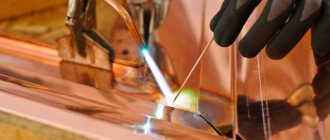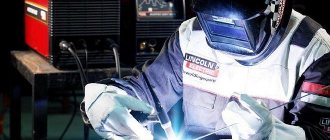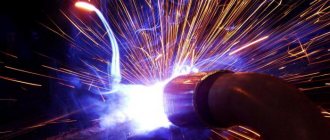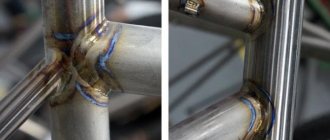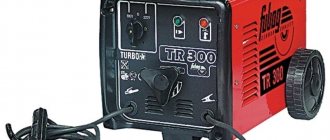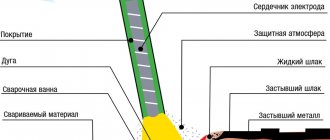At large-scale enterprises, where ships, aircraft and agricultural machinery are produced in large quantities, not entirely classical welding methods are used. It's clear why. No matter how large the number of welders in the workshop is, they will in any case not be able to ensure high labor productivity, since the human factor plays a large part here.
In such cases, alternative welding technologies are used. In this article we will talk about one of these technologies—friction welding.
Content
- Concept and definition of friction welding
- Video: the essence of friction welding
- Advantages and disadvantages of friction welding
- Advantages
- Flaws
- Continuous Drive Friction Welding
- Inertia friction welding
- Combined type of friction welding
- Oscillatory friction welding
- Friction stir welding
- Orbital friction welding
- Radial friction welding
- Roller friction welding
- Surfacing using friction welding
- Weldability of various materials
- Requirements for the design of welded parts
- Preparing surfaces for friction welding
- Selectable welding modes with continuous drive
- Heat treatment of welded joint
Volume of a thin layer of heated metal
- When using a rotational motion, friction welding gives good results only if one of the parts is a rotating body (rod or pipe), its axis coincides with the axis of rotation, and the other part is a flat surface.
The ability to use friction welding is also limited by the cross-sectional size of the part being welded at this boundary. Calculations show that it is not practical to use this process for welding solid bars with a cross-section greater than 200 mm in diameter at the current level of technological development.
To weld such rods (with a cross-sectional area of 30,000 mm2 or more) you will need a machine with a power of about 500 kW, a speed of about 100–150 rpm and an axial force of more than 300 tf (294 MPa).
Concept and definition of friction welding
Friction welding is a technological process for manufacturing a welded joint, which occurs through the use of thermal energy arising on the contact surfaces of the workpieces being joined, pressed against each other with force, and at the same time, one of the workpieces moves relative to the other.
After an interruption or complete stop of the movement of the workpiece, friction welding is stopped by applying a forging force.
As with other pressure welding methods, the welded joint is obtained as a result of joint plastic deformation of the joined sections of the welded workpieces. But a distinctive feature of the friction welding process is the generation of thermal energy directly in the joint zone due to the transformation of work aimed at overcoming the friction forces between the workpieces. These forces arise from the mutual movement of the rubbing surfaces of the workpieces being welded.
Video: the essence of friction welding
Main stages of friction welding
The main feature of this welding method is its versatility in operation. That is, friction welding equipment allows you to combine different materials into a single whole - steel, copper, brass, and so on. Friction welding has found its application in the production of valve parts for internal combustion engines, printing shafts, cross members, as well as pipes for drilling and so on. The heat treatment zone when using the friction welding method is significantly smaller than other types of welding. No weld pool appears at the junction of the material. The welding process is quite simple, but labor-intensive; it consists of the following main steps:
- Starting point: securing both working parts and starting to rotate one of them;
- Heating: both parts of the working material are pressed against each other with a certain rotational force, as a result of which the compression force causes friction, which, in turn, causes heating of the surfaces of the parts being welded;
- Welding process: at a particular moment, the part that rotates slows down, which causes an increase in compression pressure. It is at this moment that the working parts are welded together using friction.
Starting point
Heating
Welding process
Advantages and disadvantages of friction welding
Advantages
1. High quality connection. At the joint there are no many defects inherent in welds obtained using other types of welding. For example, the formation of gas pores and weld cracks, various non-metallic inclusions and other defects is eliminated at the joint.
2. Constancy of mechanical properties. As a rule, the mechanical properties of the base metal, the joint and the area near it are practically the same due to the uniform structure of the metal.
3. High productivity of the method. The entire welding cycle takes from a few seconds to several minutes, depending on the size of the parts being welded.
4. Preparation for welding takes less time. Due to the fact that there is no need to remove oxide films from the surfaces being joined and clean them, this significantly saves preparation time.
5. No additional filler materials are required, as for many other types of welding.
6. No additional post-welding operations are required, such as tempering, annealing, forging, etc.
7. Costs for subsequent machining after welding are reduced.
8. There are no welding leads and a low degree of deformation after welding is completed.
9. Large range of materials to be welded. Friction welding allows you to weld many materials, both among themselves and in various combinations.
10. High metal utilization factor (CMM). Alternative methods for producing workpieces (castings, forgings, etc.) have a significantly lower CMM.
11. Less harmful. When friction welding, there is no bright blinding light, as with arc welding, there is no release of harmful gases, and there are no splashes of molten metal.
12. Easy automation. It can be achieved by installing welding machines in automatic and rotary production lines, or, for example, by using control computers operating according to programs.
13. Environmental friendliness of the process. Welding does not require protective gases, fluxes or coatings; therefore, there is no release of harmful substances into the air.
14. Low energy intensity. Compared to conventional arc welding, energy intensity is reduced by 10 times.
Flaws
1. Low versatility of the process and a relatively small range of welded parts.
2. The dimensions of the welded parts are limited. In the case of round parts, during welding of which one is fixedly fixed, and the second rotates around its axis (rotational welding), it is not economically feasible to weld workpieces with a diameter of more than 150 mm.
3. Expensive and bulky equipment for friction welding.
4. Distortion of fibers in the welding zone is possible if the welded joint is subjected to high dynamic loads during operation.
5. Lack of mobility. It is impossible to use this type of welding in “field conditions” and various installation works, since the welding equipment for friction welding is stationary and not mobile.
Advantages
The method under consideration is characterized by quite a large number of advantages. By mixing the workpieces with friction you can get a high-quality seam. The quality of friction stir welding is improved by using different tools. The advantages include the following:
- The blanks do not need to be carefully prepared. If we consider contact and other technologies, then before direct processing the surface must be thoroughly cleaned of various contaminants and be smooth. Otherwise, the quality of the seam will be poor and it will not be possible to achieve the required tightness. In this case, it is enough to clean the surface from large and strongly visible contaminants.
- There is no need for special edge preparation. Some technologies involve removing the surface layer of metal and carrying out certain technological operations that will significantly increase the strength of the connection.
- It is possible to connect metal that cannot be processed in the usual way. An example is materials that cannot be welded using conventional welding methods. In this case, there is practically no need for preheating the processing zone.
- The strength of the resulting connection is quite high. That is why the technology can be used to produce critical products with various fields of application.
- There is no need to use filler wire. This point significantly reduces the cost of the work performed.
- At the junction the grain is fine. Due to this, the density of the weld seam and its resistance to various types of influence increases.
- The absence of pores also has a beneficial effect on the quality of the resulting compound. This property can be associated with the fact that during strong heating, various gases and substances are released, which cause the formation of porosity.
- The almost complete absence of signs of warping and thermal deformation means that finishing is required extremely rarely.
- After welding work using friction stir welding, the product is almost immediately ready for use. In this case, there is no need to carry out any preparatory actions.
- The degree of surface reaction to environmental influences does not increase. In other words, the material does not corrode.
- During the procedure, no toxic gases or other emissions are generated at the time of friction stir welding. In addition, more common methods based on the influence of current lead to the formation of an electric arc, which has a negative impact on the operator and others in the absence of special personal protective equipment.
- The production cycle time is reduced by approximately 50% compared to other common methods.
- Savings on the amount of energy consumed are 20%.
As previously noted, the production of defect-free welds on alloys has determined the widespread use of friction stir welding. An example is the receipt of body parts.
Types of friction welding, welding patterns
Continuous Drive Friction Welding
Continuously driven friction welding was the very first variation of friction welding.
To implement it, one of the workpieces is rigidly fixed, and the second workpiece is given a rotational movement, while both workpieces are bodies of rotation and are on the same axis (see diagram of friction welding with a continuous drive). Next, the workpieces are brought close together and some axial force is applied to the movable one. In continuous drive friction welding, mechanical energy is transferred directly to the joint where it is converted into thermal energy through dynamic contact between the two workpieces.
The heating stage in friction welding installations can be regulated by the heating time or the amount of mutual deformation of the workpieces. This is followed by stopping the moving workpiece and forging. Currently, in addition to continuous drive welding, quite a few types of friction welding have appeared, and now we will consider the most common of them.
Inertia friction welding
This type of friction welding differs from welding with a continuous drive in that mechanical energy is not transferred directly from the drive to the joint. This welding is based on the use of energy stored in the flywheel (see diagram of inertial friction welding).
The spindle, with the flywheel mounted on it, accelerates. After the flywheel has reached a certain moment of inertia of the rotating mass, the drive is turned off and the workpieces are compressed with a certain force. The welding process ends after the spindle stops.
The ranges of set welding parameters are as follows: speed 0.28-11.1 m/s. Compression pressure of workpieces: 47-465 MPa. The moment of inertia of the flywheel is chosen so that the angular acceleration is in the range of 150-300 rad/s2.
Combined type of friction welding
This type of welding can occur in two ways:
1) First, the workpiece rotates at a constant angular speed, and then the engine is turned off and the process is completed using the inertial method.
2) The start of welding occurs at a constant angular velocity and continues according to the inertial method. And at the moment when the spindle rotation speed reaches 5-6 rps, it instantly brakes.
Oscillatory friction welding
This type of welding occurs with angular vibration movements of one or both workpieces, or with reciprocating motion (vibration friction welding). In practice, this type of welding is used only for welding thermoplastics and thermosets together.
Friction stir welding
This is a relatively new type of friction welding, developed by the British Institute of Welding and introduced in the early 90s. The essence of such a process is shown in the figure below:
The tool, rotating at high speed, comes into contact with the welded edges at the joint and its tip is embedded into the workpiece to the full depth of the edges. In this case, the shoulder of the tool touches the joint surface. Next, the tool moves along the entire joint line. As a result of the friction of the tool tip on the workpiece, the welded edges are melted, mixed when the tool rotates, and are forced into the free area behind the moving tool.
The smooth surface of the weld is ensured by the tool shoulder, which touches the weld joint. At the end of welding, the tool leaves the joint area beyond its boundaries. We recommend watching a video that clearly shows the process of friction stir welding:
Orbital friction welding
A diagram of this process is shown in the figure.
The essence of this type of welding is that the welded workpieces pressed against each other move in orbits relative to each other. In this case, the workpieces do not rotate around their own axes. The axes of the workpieces are shifted by a certain amount e, called eccentricity. Due to this, their circular movements occur along a certain orbit, the radius of which is equal to the eccentricity radius e. When the workpieces have passed the heating stage, their axes are aligned and the circular movements stop. After this, forging is done and a welded joint is formed.
Orbital welding can be used to weld not only round workpieces. Since the workpieces do not rotate around their own axes, the shape of their ends can be any, but it is necessary to ensure uniform heat generation over the entire plane of the welded areas.
Due to the fact that the workpieces can be of any shape, this type of welding has become quite promising for joining products with a large cross-sectional area. However, not in all cases this type of welding is economically feasible due to complex equipment and insufficient reliability of clamping mechanisms. The low reliability of the clamps is due to the influence of large inertial forces on them. Because of these shortcomings, this welding method has not been widely adopted in industry.
Radial friction welding
The essence of this welding method is the use of heat generated by the friction of the outer or inner ring, which rotates at a certain angular speed, while coming into contact with the beveled ends of the pipes, pressed against one another with some force.
The diagram of radial friction welding is shown in the figure. While rotating, the ring heats up the ends of the pipes and at the end of the heating stage, then the rotation of the ring is stopped and it is further compressed in the radial direction.
Roller friction welding
This type of welding is used in cases where it is necessary to weld thin-sheet elements. The roller welding diagram is shown in the figure.
The essence of this method is that a roller rotating at a speed of approximately 1600 rad/s is brought to the edges of the workpieces. The roller moves relative to the edges being welded at a speed of 0.1-2.0 m/s, and the pressure created on the roller is in the range of 0.2-0.5 MPa.
Surfacing using friction welding
This surfacing is used in cases where it is necessary to restore worn surfaces of parts, or when it is necessary to ensure certain operational properties on the surfaces.
The friction surfacing scheme is shown in the figure. A rotating rod with an angular velocity of the order of 1600 rad/s is pressed against the surface on which surfacing must be performed, with a force F, and the surface itself moves with a linear speed Vzag. The thermal energy generated as a result of friction creates a thermal field that heats both the workpiece and the rod. In this case, the rod heats up much more due to the fact that the contact surface of the workpiece is constantly changing as it moves, but the contact surface of the rod remains unchanged. As a result, the rod melts and a layer of metal is transferred from the rod to the surface of the workpiece.
Welding sequence
After the heated workpieces begin to settle, they are partially forged. This stage of operation is carried out automatically by the friction joining machine. In cheaper, semi-automatic machines, it is necessary to control the welding process according to the readings of instruments, in particular, a force meter and a pressure gauge.
After the process is completed, the matrix is removed from the installation, the connected workpiece is removed from the clamps and immediately placed in the thermostat. Such a transition is necessary in order to quickly anneal the welded joint. In order to protect the workpiece from thermal shock caused by significant temperature changes
This is especially important for steels that are prone to temper brittleness - stainless, high-carbon and high-alloy steels
The initial temperature inside the thermostat is set at least 150-1800C. The thermostat slowly cools the joint until the temperature drops to 500C. The compound can then be either annealed or used directly.
The process under consideration can also be used for workpieces that have two joints. To do this, first, the first of the joints is prepared using the method described above, then the semi-finished product is placed in a thermostat with a temperature of 750-800 0C and kept there for at least 2.5-3 hours. Next, the resulting joint is cleaned from macro welding defects. The cleaned workpiece, without trimming the second joint, is secured in the spindle or in the support and the second joint is welded. Subsequent transitions do not differ from single-butt friction welding technology.
In repair shops, as well as in everyday life, conventional lathes can be successfully adapted for friction welding. You must first calculate the permissible axial force on the spindle and compare the obtained value with the required one.
The technological parameters of some of the most common domestically produced machines on which products are connected by friction are given in the table:
The sequence of butt jointing of parts by friction can be seen in the demonstration video:
Searching for records using a filter:
Friction welding technology
Localization of the thermal field and plastic deformation during the welding process ensures low energy consumption and allows welding of dissimilar metals, such as aluminum-copper, aluminum-steel, copper-cermets and others. In addition to saving energy, friction welding reduces the cost of subsequent processing of the welded joint.
Weldability of various materials
Data on the weldability of various metals and alloys to each other are given in the table below:
Requirements for the design of welded parts and equipment capabilities
When designing workpieces produced by friction welding, the following factors must be taken into account: the capabilities of the welding equipment, the ability to weld materials together, and securing the workpieces in the welding machine. The cost of preparing workpieces for welding and subsequent processing of the resulting joint, automatically obtaining the necessary alignment and angular position of workpieces, and creating, if necessary, a uniform temperature field and equal deformation conditions are also taken into account.
When assigning allowances for the length and diameter of workpieces, take into account the data given in the table.
In order to ensure the required alignment of the workpieces, it is necessary to securely fasten them in the clamping fixtures of the welding machine. In addition, an important indicator is the rigidity of the workpieces being welded along the length of their extension from the clamps. Recommendations for this length are shown in the figure:
If the overhang length is less than recommended, this may result in thermal release of the clamping fixtures.
Preparing surfaces for friction welding
When friction welding, the condition of the surfaces being welded has a much smaller impact on the quality of the welded joint than with other pressure welding methods. Surfaces for welding can be obtained by cutting with a guillotine, a circular saw, or even a gas cutter. Irregularities on surfaces will be eliminated by grinding in or additional heating time.
Deviation from parallelism of welded surfaces can reach 5-7° and this will not have a significant impact on the quality of welding. Small areas of corrosion, paint residues, oil and other contaminants on surfaces are removed during the heating stage. The exception is rust and scale obtained during rolling, forging or stamping.
When dissimilar materials are welded, more thorough surface preparation is necessary. For example, when welding aluminum to steel, the amount of end runout of the steel workpiece should not exceed 0.2 mm. The figure below shows some examples of preparing welded surfaces from dissimilar materials.
Selection of continuous drive friction welding modes
One of the main indicators is the rotation speed. As it increases, the weld becomes more uniform and the strength indicators increase. The rotation frequency is calculated based on the optimal speed V, m/s: for ferrous metals and alloys 2.6-3, for aluminum and copper about 2, for titanium 4-5.
Specific heating pressure. When welding carbon and low-alloy steels it is 30-60 MPa, for heat-resistant and tool steels 60-120 MPa, for welding aluminum and aluminum alloys 7-23 MPa, for welding copper with aluminum 40-60 MPa, aluminum with corrosion-resistant steel 6.4-12, 2 MPa, for welding titanium and titanium alloys no more than 18 MPa.
In practice, when welding homogeneous materials, the specific heating pressure can be varied within wide limits, obtaining a high quality welded joint. When welding dissimilar materials, the optimal heating pressure should be selected based on the deformation rate in a range that will ensure the same degree of deformation of both welded edges.
Specific lapping pressure. It is prescribed to improve the performance of welding equipment. Typically 15-20% of the specific heating pressure. For welding carbon steels it is approximately 10 MPa. The grinding time is 1-3s.
The specific forging pressure is selected based on the plastic properties of the materials being joined. Most often, the forging pressure is 100-300% of the specific heating pressure. When welding aluminum with corrosion-resistant steels, the forging pressure is selected within 800-1000% of the heating pressure. Forging time is usually 1.5-3s.
Heating time. This indicator greatly affects the cyclic strength and impact toughness of the welded joint, especially when welding dissimilar materials. The heating time is determined experimentally for each specific pair of workpieces. Increasing the heating time leads to grain growth.
Braking time. It should be as short as possible so that the flow of metal from the welded joint does not become stable. Intensive metal flow and sudden cooling prevent stress relief in the welded joint, and this reduces the strength and can lead to destruction of the joint immediately after the welding process is completed.
Heat treatment of welded joint
With the help of heat treatment, internal stresses in a welded joint are reduced, plastic properties are increased, recrystallization occurs and the quality of welding is improved as a result of diffusion processes.
Heat treatment is not carried out when welding low-alloy, high-alloy chromium-nickel austenitic and chromium ferritic steels welded in homogeneous and dissimilar combinations.
Medium-carbon alloyed and unalloyed steels, as well as high-alloy austenitic-martensitic, chromium ferritic-martensitic steels, welded in various combinations with each other, are subjected to heat treatment. Moreover, if the carbon equivalent of steels is above 0.8%, heat treatment is carried out from a heated state.
general information
Friction welding (or friction welding) is a method of joining homogeneous and dissimilar metals, the essence of which is to heat two parts by rubbing them against each other. The heat generated during friction melts the metal, forming a permanent connection. But friction is not the only thing used during welding. Here, the forging of parts after welding, as well as the pressure exerted on the workpieces, also plays a big role.
As you can see, the essence of friction welding is extremely simple, which is why such welding equipment is used in many modern industries. This method allows you to improve the quality and productivity of labor without hiring additional highly qualified employees. It is enough to train the welder how to properly configure the equipment; the rest of the processes take place automatically.
Friction Welding Equipment
The schematic diagram of the continuous drive friction welding machine is shown in the figure below:
The equipment for friction welding may include: a welding machine, a mini-computer with programs for mode parameters, a deburring machine, manipulators for loading and unloading, and transportation devices.


